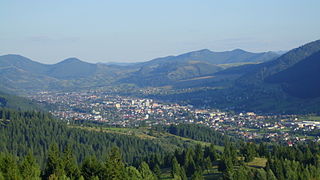
Botoșani County is a county (județ) of Romania, in Western Moldavia, with the capital city at Botoșani.

Suceava County is a county (județ) of Romania. Most of its territory lies in the southern portion of the historical region of Bukovina, while the remainder forms part of Western Moldavia proper. The county seat is the historical city of Suceava, formerly the capital of the Principality of Moldavia during the late Middle Ages and then a pivotal, predominantly German-speaking commercial town of the Habsburg/Austrian Empire at the border with the Kingdom of Romania throughout the Modern Age up until 1918.

Vatra Dornei is a city in Suceava County, north-eastern Romania. It is situated in the historical region of Bukovina. Vatra Dornei is the fifth largest urban settlement in the county, with a population of 14,429 inhabitants, according to the 2011 census. It was declared a municipality in 2000, being the newest and smallest municipality in the county. The city administers three villages: Argestru, Roșu and Todireni. Vatra Dornei is a well known spa and ski resort in the Carpathian Mountains and also is home to the historic Vatra Dornei Casino.

Câmpulung Moldovenesc is a city in Suceava County, north-eastern Romania. It is situated in the historical region of Bukovina.

The Bukovina Germans are a German ethnic group which settled in Bukovina, a historical region situated at the crossroads of Central and Eastern Europe. Their main demographic presence lasted from the last quarter of the 18th century, when Bukovina was annexed by the Habsburg Empire, until 1940, when nearly all Bukovina Germans were resettled into the Third Reich as a part of Heim ins Reich national socialist population transfer policy.

Dorohoi County, with its seat at Dorohoi, was a subdivision of the Kingdom of Romania and located in the region of Moldavia.

Gheorghe Flondor was Romanian politician who served as Royal Resident of Ținutul Suceava from February 7, 1939 to September 23, 1940.

The regions represented the result of a Soviet-inspired experiment regarding the administrative and territorial organisation of the People's Republic of Romania between 1950 and 1968.

Botoșani Region was one of the newly established administrative divisions of the People's Republic of Romania, copied after the Soviet style of territorial organisation. It existed until 1952 when it was merged into Suceava Region.
Suceava Plateau is a geographic area in the NE Romania, and SW Ukraine. Suceava Plateau is the NW part of the Moldavian Plateau. It has altitudes that exceed 700 m and long ridges, such as:

Line 500 is one of Căile Ferate Române's main lines in Romania, having a total length of 488 km. The main line, connecting Bucharest with the Ukrainian border near Chernivtsi, passes through the important cities Ploiești, Buzău, Focșani, Adjud, Roman, Pașcani and Suceava.

This article discusses the administrative divisions of the Kingdom of Romania between 1941 and 1944. As a result of the Soviet occupation of Bessarabia and Northern Bukovina, Second Vienna Award and the Treaty of Craiova, territories that had previously been part of Romania were lost to the Soviet Union, Hungary and Bulgaria respectively. By September 1940 the administrative system set up in 1938 based on 'ținuturi' (regions) was disbanded and the former counties (județe) were reintroduced.

Moldavia, also called Western Moldavia or Romanian Moldavia, is the historic and geographical part of the former Principality of Moldavia situated in eastern and north-eastern Romania. Until its union with Wallachia in 1859, the Principality of Moldavia also included, at various times in its history, the regions of Bessarabia, all of Bukovina, and Hertza; the larger part of the former is nowadays the independent state of Moldova, while the rest of it, the northern part of Bukovina, and Hertza form territories of Ukraine.

Câmpulung County is one of the historic counties of the Kingdom of Romania, in the historical region of Bukovina. The county seat was Câmpulung Moldovenesc.

Rădăuți County was one of the historic counties of Bukovina, Romania. The county seat was Rădăuți.
The 2008–09 Liga IV Suceava was the 41st season of the Liga IV Suceava, the fourth tier of the Romanian football league system. The season began on 23 August 2008 and ended on 6 June 2009.
The Bukovina Day is a public holiday of Romania celebrated every 28 November that commemorates the decision of the General Congress of Bukovina to unite the region of Bukovina with Kingdom of Romania on 28 November 1918.
















